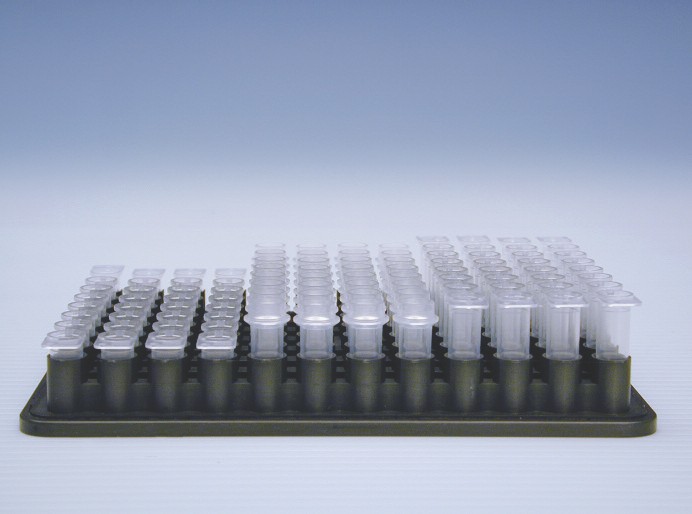
The difference between low, regular and high profile strips
Differences in Low Profile, Regular Profile and High Profile products
Although low profile tubes were introduced in the marketplace back in 2000, some companies have renamed the original low profile 0.2 ml vessels description to 0.1 ml “vessel”. Low profile (0.1 ml) products are used in “fast cyclers” from ABI, Roche 480 cyclers as well in (q)PCR cyclers with height adjustable lids. The difference
between low profile 0.1 ml vessels and regular profile products is the height of the product and consequently the volume it can hold. More than half of a regular-profile strip remains above the thermal block level. In low profile tubes there is a smaller “air” volume above the reaction mix than in regular and high profile tubes. This allows less reaction mix to go into gas phase, leading to less concentration of the samples, less change in reaction conditions and therefore to more reproducible results. Most fast cyclers accept low profile tubes, strips and plates. Most regular PCR cyclers accept regular profile and high profile file products. (tubes, tube-strips and plates). Thermal cyclers without height-adjustable heated lids accept only one type, mainly regular profile products. BIOplastics products are available in all profile versions. The differences between low profile (0.1ml), regular profile and high profile products are shown in the illustrations and photographs below.
Low Profile (LP), Regular Profile (RP), High Profile (HP), Fast Cycler, 0.1 ml, 0.2 ml tubes?
The industry did muddle the issue and customers are confused about "what is what".
Find the similarities and differences below:
Low Profile (LP)
Regular Profile (RP)
High Profile (HP)
= 0.1 ml tube/plate
= 0.2 ml tube/plate
= 0.2 ml tube/plate
height without closure: 15.6-16.3 mm
height without closure: 20.9-21.5 mm
height without closure: 22.5-24.0 mm
Differences in Low Profile, Regular Profile and High Profile products Image2
Raw material and product properties
The polypropylenes used are of the highest medical grade polypropylene, which ensures no release of metals or other contaminants into the reaction mix. The carefully selected types of medical grade polypropylenes are “in house blended” to well-defined proprietary ratios. This specific fine tuned blend supports achieving the highest product and user performance properties.
Table BIOplastics Raw material composition properties
| Type of vessel | Application | Competitor vessel | BIOplastics tubes (M type) | BIOplastics (O type) |
|---|
| (q)PCR tubes, strips, plates | Binding to DNA % | Up to 2% | NA | < 0.3% |
| | Binding to proteins % | Up to 4% | NA | < 0.8% |
| | Temperature work range °C | mainly -20 to 100 °C | NA | -30 to 100 °C |
| Microcentrifuge tubes 0.5, 1.5 & 2 ml | Binding to DNA % | Up to 5% | < 0.6% | < 0.3% |
| | Binding to proteins % | Up to 6% | < 0.6% | < 0.6% |
| | Pop-Open at 99 °C | yes > 80% | No | No |
| | Temperature work range °C | mainly -20 to 99 °C | -80 to 100 °C | -80 to 100 °C |
| Screw cap tubes 0.5, 1.5 & 2 ml | Binding to DNA % | Up to 5% | < 0.6% | < 0.3% |
| | Binding to proteins % | Up to 6% | < 0.6% | < 0.6% |
| | Accept organic solutions | No > 95% | Yes | Yes |
| | Temperature work range °C | mainly -25 to 100 °C | -200 to 100 °C | -80 to 100 °C |
| Titer dilution and storage tubes | Binding to DNA % | Up to 4% | < 0.6% | NA |
| | Binding to proteins % | Up to 4% | < 0.6% | NA |
| | Temperature work range °C | mainly -25 to 100 °C | -180 to 100 °C | NA |
The EU Gold Standard for (q)PCR
BIOplastics BV has set the EU Gold Standard for (q)PCR by being in control of all variables in the process starting from the principle design up to the final packaging, with products of superior performance relative to signal, closure, evaporation, and reproducibility.
Anti-static pipette tips. Why, how, and when they become favorable.
BIOplastics pipette tips are designed for use in molecular biological applications and more specifically for pipetting DNA, RNA, proteins and solutions commonly used in and around the (q)PCR process. BIOplastics has optimized its pipette and filtertips by means of design and raw material selection to meet the highest requirements. By selecting medical grade materials with anti-static properties BIOplastics has reduced the biological molecule binding to the lowest possible. BIOplastics pipette tips become favorable when pipetting slightly basic buffers, salt solutions and biological molecules (Proteins, DNA, RNA). Differences in hydrophobic and hydrophilic properties of solutions, raw material surface and biomolecules cause a pipetting difference “phenomenon” as shown below. If pipetting water contact us for regular “old type” tips.
Anti-static pipette tips. Why, how, and when they become favorable Image